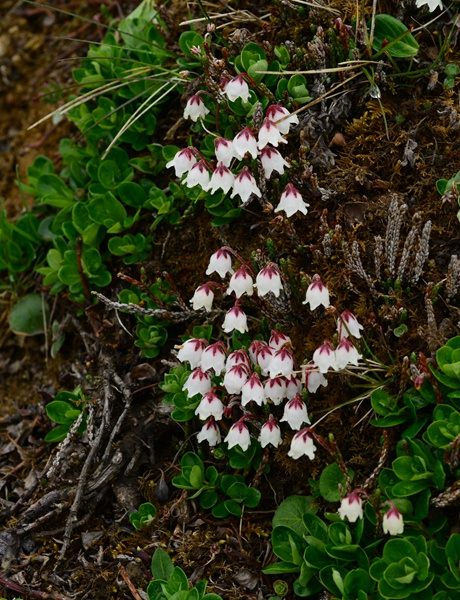
- Scientific Name: Cassiope selaginoides Hook.f. & Thomson
- Ref: Hooker’s J. Bot. Kew Gard. Misc. 7:126. 1855
- Synonym: Cassiope mairei H.Lév.
- English Common Name:
- Chinese Common Name: 锦绦花 jǐntāo∙huā, 岩须 yánxū, 长梗岩须 chánggěng yánxū
- Family: Ericaceae
- Genus: Cassiope
- Distribution: Rhododendron thickets, alpine grasslands, rocky slopes, cliffs; 3000–4200(–4500) m. W Sichuan, SE Xizang, NE Yunnan [Bhutan, Myanmar, Nepal, Sikkim].
- Photo: 06/20/2014, Baima Snow Mt., Yunnan
Shrubs 10–20 cm tall. Stems initially decumbent, ultimately erect, glabrous or pubescent. Leaves assurgent; leaf blade ovate-triangular, 2–3 × 1–1.5 mm, cymbiform, leathery, abaxially deeply furrowed, furrow nearly reaching apex and divergent near base, furrow rim densely pubescent, adaxially concave, glabrous, margin not membranous, fringed with wool-like hairs, glabrescent. Flower nutant. Pedicel 0.5–1.6 cm, densely crisped-tomentose. Calyx crimson or reddish brown; lobes oblong to elliptic, ca. 3.8 mm, glabrous or puberulous, margin membranous, inconspicuously ciliolate. Corolla pure white, reddish within at base, broadly campanulate, 6–8 mm; lobes erect, oblong, 2.5–3 mm. Stamens ca. 2.5 mm; filaments pilose; awns ca. 0.9 mm. Capsule 2–3 mm in diam. Fl. May–Jul, fr. Jun–Sep. (Flora of China)
